About this blog: For your first visit to the Grand Canyon, this blog is a helpful guide to the South Rim of the National Park. I write about the picturesque stops along the rim to see the Grand Canyon. The small day hikes to experience the canyon up-close. The iconic El Tovar Hotel and other lodges in and around the National Park. Tusayan and Flagstaff, the cities close to the Grand Canyon South. An approximate budget for a long weekend spent at the Grand canyon. You will find answers to all these and more travel tips and safety guides while visiting the oldest canyon of the continental America!
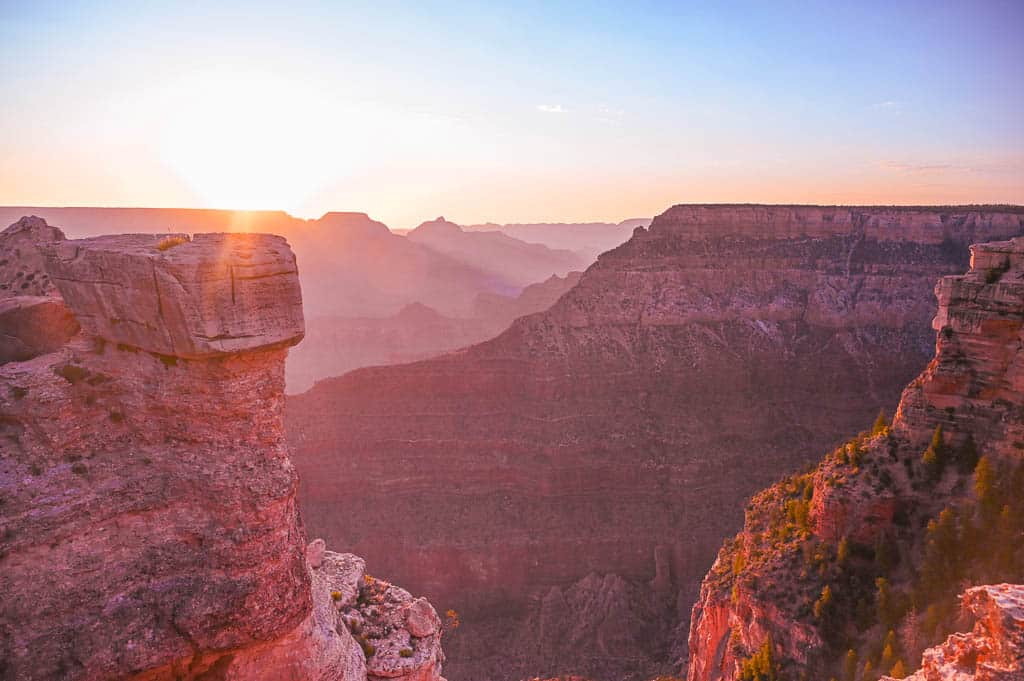
The Grand Canyon is one of the iconic travel destinations of the United States. The unique geological formation of Southwest state of Arizona inspires awe in every nature lover and adventure seeker.
You can explore Grand Canyon from the North Rim, the South Rim and the West Rim. If time is a concern, you can visit any one of these rims and still experience brilliant nature. The South Rim is the most visited part of Grand Canyon (more on that later).
Alternatively, you can visit the South Rim of the Grand Canyon as a day trip from nearby cities like Las Vegas or Flagstaff. Choose your mode of transport between a private vehicle, bus, helicopter or a train. Many choose do a complete rim to rim hike of the Grand Canyon NP and camp at different sites for over a couple of nights.
You may also spend a leisurely vacation at the South Rim of the Grand Canyon for a couple of days, say a long weekend. If not a complete rim to rim hike, you can (and should) opt for few smaller hikes in the Grand Canyon National Park for an intimate experience of the natural formation and river Colorado.
It does not take more than a couple of hours to “see” the Grand Canyon. However to fully experience the natural wonder of the world, you need at least 2 days to experience the canyon up close and personal. I recommend staying for a couple of nights inside the National park (or nearby) and spend time at different view points, driving the many shuttle routes of Grand Canyon or even going for day hikes in the Canyon.
What’s the Big Deal about Grand Canyon?
Grand Canyon is one of the natural wonders of the world.
The Grand Canyon is 10 miles deep and 18 miles wide at an average. It runs a course of 287 river miles across the desert land of American Southwest. They say the course of Colorado river and her long work of erosion can be traced back from the space.
These are just numbers. Nothing, absolutely nothing can prepare you for a visit to the Grand Canyon!
Fun fact- the Grand Canyon is not even the deepest in the world. The Kali Gandaki canyon in Nepal. The Cola Canyon in Peru. The Colombia river gorge in Washington. These are some of the deeper canyons compared to the Grand Canyon. Yes it is only the Grand Canyon which made it to the list of natural wonders.
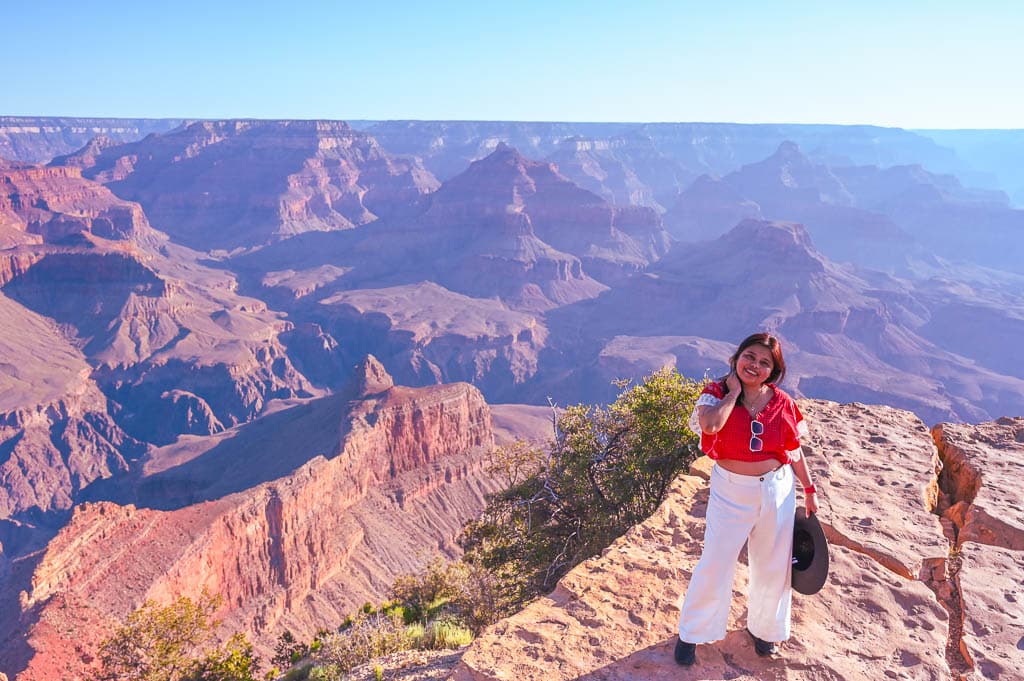
Grand Canyon stands out in the way its rock formation tells the history of the Earth. The deeper you go down the gorge you discover rocks aged between few million to billion year old. Some of the oldest rock formation of American continent reside in the area. For a geologist, the canyon is an open book, turning pages of the history and telling you stories from ancient oceans, river bed and granite shields.
Deep within the canyon, you will see a faint flow of the river Colorado. Once you go down the depth of the canyon, you go closer to the river. Over a millions year and more, river Colorado has accomplished a massive work of erosion, making steep plunge measuring more than thousand meters at spots. It becomes more prominent as you leave behind the cacophony of human civilization and set your soul free in the profoundness of nature.
Each layer of rocks unfolds a different chapter of geological history of the North American continent. Deep inside the canyon, lies buried unexplored complex network of caves, karst deposits, volcanic residue, fossil remnants of dragon fly and reptiles.
No wonder the Navajo of the ancient land worshipped the Canyon.
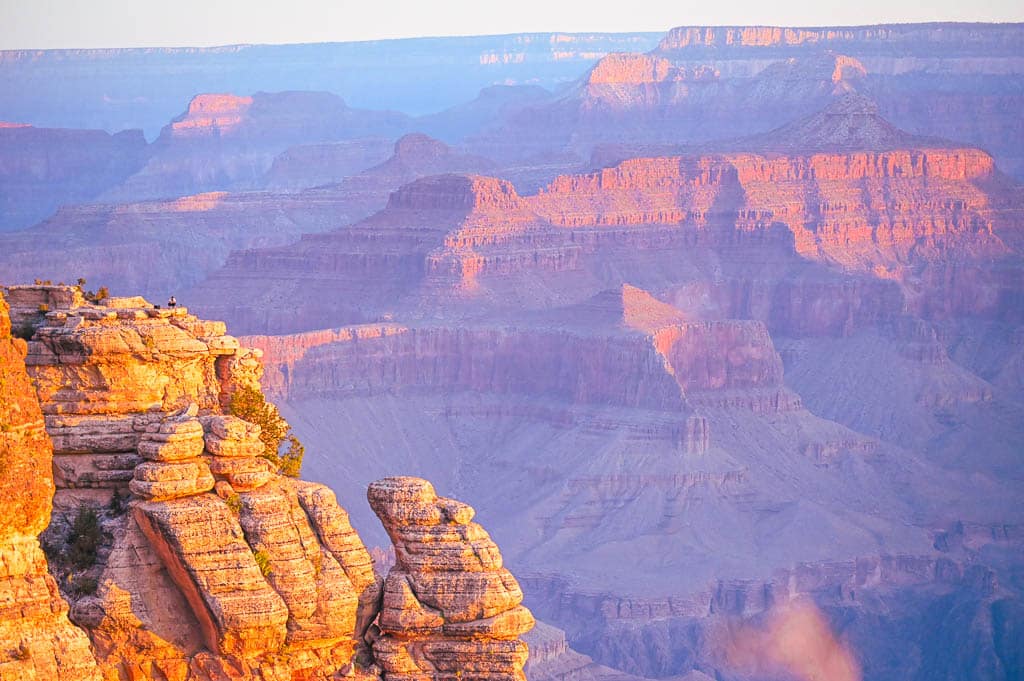
First Impression of the Grand Canyon
Conflict and overwhelm- you can experience both at the edge of the Grand Canyon.
Or so I did!
I am just a simple girl who wishes to see the world. Having zero to no knowledge to read rocks, I recall my days spent at the edge of the Grand Canyon, watching the azure sky turn livid during golden hours. I realized my tiny existence against the billions of years of history this pale blue dot of a planet has with this universe. I question my purpose under a sky studded with far reaching galaxies.
I remember feeling overwhelmed at the magnitude of time etched in the soil of that canyon snaking up the northwestern Arizona. And I repeat, no matter what I say, nothing prepares you to witness and soak in the grandeur of the Grand Canyon.
I am from the land of Himalayas. Deep gorges and old canyons are part of our civilization, through which water seeps into the land and makes a fertile India with a billion and some more population, completely secured in food! Yet, nothing absolutely nothing comes close to comparison with the Grand Canyon.
The South Rim of the Grand Canyon starts from Mather point, a panoramic view point sitting very close to the visitor’s center.
It was during the break of the dawn, I looked at the horizon painted pretty pink with the rising sun. A deep gorge drops down from the cliff where a handful of photo enthusiasts stand. This part of the park seems to be pretty accustomed to human footfall, with a visitor center and tourist friendly build ups.
I would not exaggerate when I say I felt a surge to say yes to the call to go down the deepest point of the gorge. Deep in the canyon closer to the metamorphic quartz base where Vishnu Schist, the oldest rock form of the region is located. A delight to the Geologists of the world, Vishnu Schist is estimated to be of an age of 1.8 billion years! It records the history of the Grand Canyon’s tumultuous formative years.
Mather Point was both a sea bed and a sky high mountain range at some point of time!
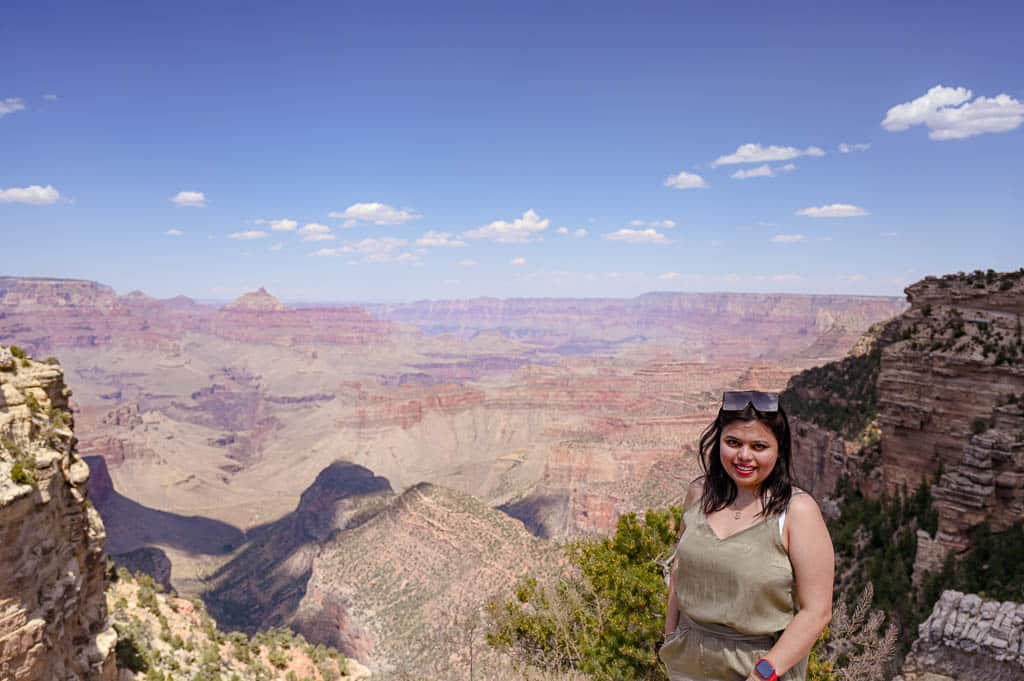
The best view of Grand Canyon
The South Rim of Grand Canyon
The South Rim of the Grand Canyon attracts the maximum number of tourists to the Grand Canyon.
Arguably, this is where you get the best view of the canyon from different viewpoints, see the sheer drop of the long standing walls, stand at the Desert view to see how river Colorado paves way for the plainland, the flora and fauna of the canyon, start small hikes and access the visitor centres. The South rim is also home to a couple of national park lodges if staying inside the canyon is part of your plan.
From the south rim, you can drive down a paved road to the East entrance. In short you see more of the canyon if you are visiting it from the South Rim, even for a short time.
The South Rim of Grand Canyon has well developed tourist infrastructure, a network of shuttle service, many trails, multiple visitor centers.
The best part of the Grand Canyon South Rim is it is open for all the seasons, including the icy winter months, when the North rim is not accessible.
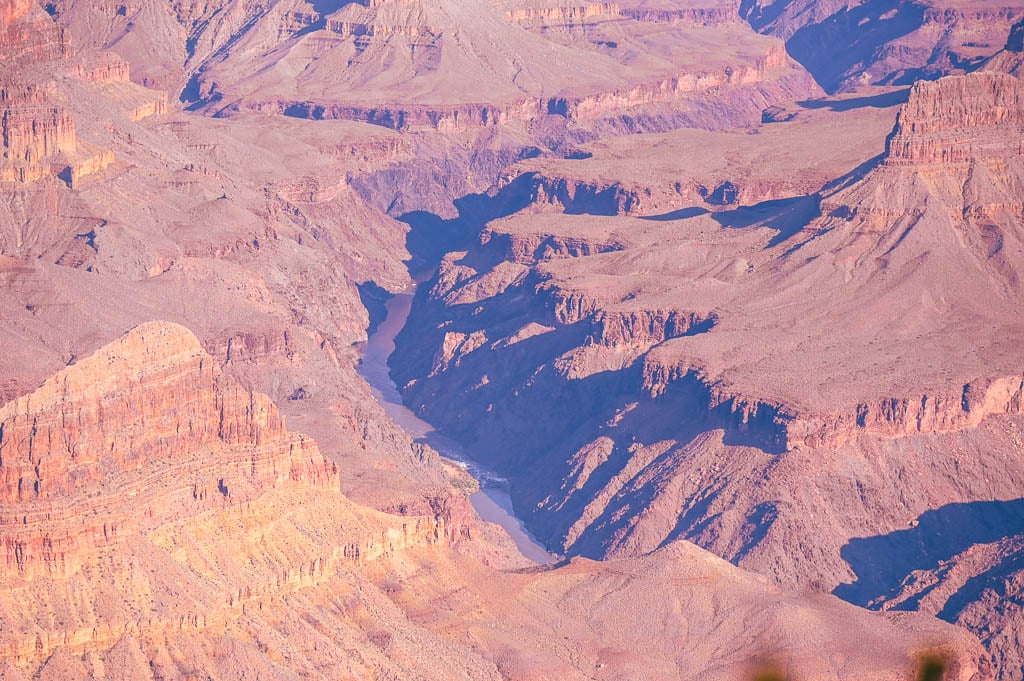
The North Rim of Grand Canyon
The north rim of the Grand Canyon does not have many footfalls. Many complain lack of viewpoints and infrastructure adds fuel to the flame. However, the north rim boasts of the maximum density of wildlife in the national park. From bison to cougars to pink rattlesnakes, there is no dearth of wildlife sightings when you approach the canyon from the North.
The viewpoints are is limited in number. You need to drive a couple of mile further to access the north. The North rim boasts of stunning sunset vista of the Grand Canyon.
Fun fact. At certain places, the distance between the North and the South rim is 17 miles (as the pigeons fly). However, to reach the north, you need to drive at least at least 5 hours (220 Miles/ 354 km).
The North Rim is NOT open for Spring, Summer and Fall season. Winter in the North rim is harsh and shuts down all the business around the park.
The North rim of the Grand Canyon is approximate 7 hours journey from the Salt Lake City.
Distance from Major Cities to the Grand Canyon North Rim
Jacob Lake to the North Rim: 30 miles / 48 km/ 1 hour
How to get from Page to Grand Canyon North Rim: 105 miles / 168 km/ 3.5 hours
From Flagstaff to the Grand Canyon North Rim: 207 miles / 333 km/ 5 hours
Phoenix to North Rim: 351 miles / 565 km/ 7 hours
From Sedona: 236 miles / 380 km/ 5.5 hours
Las Vegas to the Grand Canyon North Rim: 275 miles / 443 km/ 5.5 hours
The West Rim of Grand Canyon
The West Rim is a popular spot for tourists visiting the canyon from Las Vegas on a day trip by bus with stops at colourful Seven Magic Mountains and the Hoover Dam. It has limited view points compared to the South rim however it has the iconic glass walk on the Canyon. The glass walk is one of the largest cantilever bridge on a 4000 meter deep canyon.
The West Rim is NOT a part of the National Park. It is a different (many say inferior) experience compared to the South Rim and costs you a whooping USD 50 per person that includes shuttle service to few view points.
It is privately owned by the native community of the Navajo nation (Hualapai Tribe). You can also take helicopter tour, zipline and Colorado river rafting from the West Rim.
The Glass walk on the West Rim of the Grand Canyon protrudes 70 ft/21 Metres from the canyon rim. Fess that you for the West Rim can not be clubbed with the entry fee for the South or the North of the rim.
Las Vegas to Grand Canyon West: 126 miles / 202 kilometres / 2 hours
Via Kingman from other cities in Arizona: 71 miles / 114 kilometres / 1.5 hours
For the first time visitor, I recommend visiting the South Rim of Grand Canyon.
You get to drive, you get to see different viewpoints of the canyons, you can opt for smaller day hikes too.
For calm and peace, the North Rim is more preferred despite limited view points and activities.
It does not make sense to visit the North and the south rim of the Grand Canyon in one day as it leaves you with only a few minutes to check out a handful of viewpoints and you spend most of the day in the vehicle typing to commute between the rims.
You can visit the North of the Canyon after you have spent a few days at the South, seen the view points, walked a few trails, and explored the museums. There are a bunch of things to do at the South Rim of the Grand Canyon.
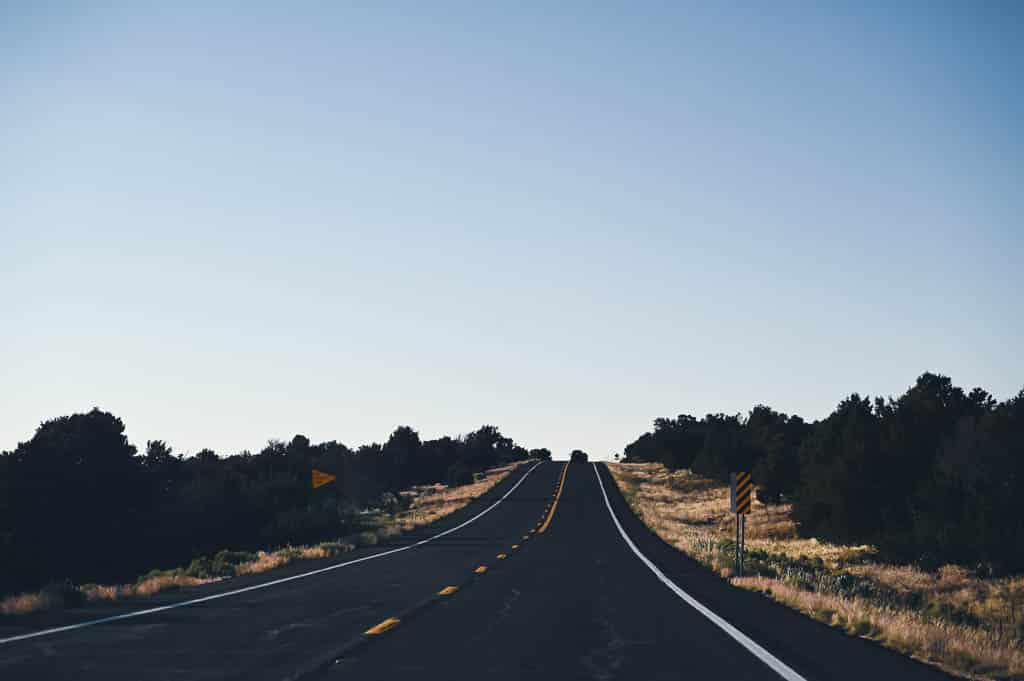
How we planned a 2 nights & 3 days trip to Grand Canyon
We flew to Phoenix at the beginning of July. We were flying from the east coast (EWR- Newark airport) and the flight itself took more than 8 hours with delays and other errands.
After spending the night at the Crown Plaza Airport hotel, Phoenix, we borrowed a rental car from Hertz and headed straight to Tusayan a small village located at a distance of 7 km from Grand Canyon South Rim Entrance.
Enroute South Rim of the Grand Canyon, we stopped at Flagstaff for a delicious Greek lunch, played country music while riding the iconic Route 66, raced with the Train to Grand Canyon, sped against the still silhouette of Kaibab national park and reached the empty town of Tusayan! We stayed at the Red Feather Lodge.
At night, Tusayan becomes eerie. The town has one Mexican restaurant and a couple of steak houses. We ordered in from the Mexican place.
The next day, we started at the break of the dawn and headed straight to Mather point to witness a magnificent sunrise. Everything the light touches is yours !I remembered the words from Lion King.
This is real and raw America, the continent European settlers “discovered” and brought to the rest of the world. This is where Man’s conquest started and this is where it ends.
From Mather point, we headed towards the Hermit’s rest point. Many blog posts suggested we can drive down however in reality roads were closed for private vehicle. We were encouraged to use the free shuttle bus inside the national park. Parking vehicle was free.
I can not emphasize enough on this. Please start the day early. The heat is tolerable. The breeze is sweet. The bus is empty.
As the day progressed, and as it was the 4th July holiday, the number of tourists increased, so did the weight time for shuttle service with queue as large as a few hundred people at some spots.
Also starting early gives you an edge over the brutal nature if you are going for short day to day hikes. Summer at Grand Canyon is HOT.
We started towards the east entrance of the Grand Canyon, also known as the Desert View point, at noon. We were heading towards Page. Our intent was to spend the night there and visit the Antelope Canyons for the next morning.
The paved road towards the right of the Mather point (also known as Purple Route) is a delight to drive in. The pine trees, the condor spreading his wings atop my head, the profound rocks in different shapes, trails aiming for the end of the canyon, the one that leads straight to the copper mine of yester years.
I wonder what would have been the fate of the Grand Canyon had it been gold instead of copper. Or oil?
In no time, we reached the desert view point right next to the east entrance. I highly recommend this drive. You get a holistic idea of how the canyon has formed various geological forms of the gorge over 1.8 billion years. You see the towering ranges as well as the progress of the river on plainland layered with green grass.
The sunset also brings out the surreal livid colors of the rocks. Thus, we experienced the Grand Canyon in a day with multiple viewpoints and did not have to hike. This was our experience as a first time visitor to the Grand Canyon in summer. This trip can be easily replicated in winter months.
You can either visit Zion National park, or Bryce, or Monument Valley, or Sedona or Page from the Grand Canyon. We chose to visit Page for 2 nights.
Had I been fortunate to spend a complete week on the road, I would have indulged in the classic Utah road trip!
At the Grand Canyon, there is a bunch of activities for every kind of travellers. You can visit the Canyon as a solo traveler or you can bring your friends and family, even kids. You may camp or do the bucket list rim to rim hike spread over a couple of days or more. You can outdoor activities like hiking, camping, wildlife, stargazing, photographic the swirls of colour on the rock or enjoy scenic drives on the far stretched routes.

How to visit Grand Canyon- Which city to fly in to?
Official estimates state more than 5 million people visit the Grand Canyon every year, however only a fraction of the number spend a night near the park. Most people visit the Canyon as a part of conducted day trip from the nearby big cities. Most of the tourists come to Grand Canyon as a part of day trip from Las Vegas. Many stop by the Canyon as a part of the famous Southwest road trip across the Canyonlands, Utah.
You can fly to any of the big cities located close to Grand Canyon and then do a road trip to the National Park. Many opt for a day trip to Grand canyon by Bus, the Old Train or a helicopter.
I would suggest try to give at least a couple of days for a more immersive experience at this natural wonder. Day trip to Grand Canyon will leave you waning for more of it.
The closest airport to the Grand Canyon is at Flagstaff. However it has limited airport service.
The big cities close to the Grand Canyon are: Las Vegas, Phoenix, and Flagstaff.
- Las Vegas to the Grand Canyon: 4-hour drive
- Phoenix to the Grand Canyon: 3.5-hour drive
- Flagstaff to the Grand Canyon: 1.5-hour drive
From Nevada Utah or Salt lake City, the North Rim of the Grand Canyon is closer. That would be around 7 hours drive if traffic is not bad. Las Vegas has an international airport (McCarran International Airport- LAX) making it easily accessible from other countries, especially from the ones from Central and South America.
Where to stay close to South Rim of Grand Canyon
To reach the South rim of the Grand Canyon, you can either spend the previous night at Flagstaff or at a small town right next to the park named Tusayan. The closest town from the South Rim is Williams (33 miles west of Flagstaff), Arizona which has only a few hotel rentals. They sell out fast in summer.
Tip: Williams is famous for the vintage train. The historic route connects the south rim of the Grand Canyon with a daily locomotive.
Quick look at the driving distances from major cities to the Grand Canyon South Rim.
- Flagstaff to Grand Canyon: 80 miles / 130 km / 1.5 hours
- Phoenix to the Grand Canyon: 230 miles / 370 km / 3.5 hours
- Williams to the South Rim by a car: 65 miles / 100 km / 1 hour
- From Sedona: 120 miles / 19 5km / 2 hours
- Las Vegas to the Grand Canyon South Rim: 280 miles / 450 km / 4.5 hours
- Los Angeles: 500 miles / 800 km / 8-9 hours (on the iconic Route 66)
Flagstaff
Flagstaff is a nice town having the option of more tourist activities however it requires you to drive for a couple of hours to reach Grand Canyon in morning.
Flagstaff is more fun at night with more things to do, and a nice streets to walk in with cafe, bookstore and many restaurants compared to the National Park or Tusayan village.
The pain point of staying at Flagstaff is when you would try to enter the park, especially on the peak holiday seasons of the summer months. You will find a long queue jostling at the park entrance. This is an unpleasant experience to start the day at the National Park.
To avoid this, I recommend a stay inside the park or at the nearby villages.
Tusayan
Tusayan, on the other hand, has zero to little options to explore except for a Visitor center. You can watch the film there that tells you in detail how the canyon was formed, and about its current inhabitants.
Tusayan has a nice camp ground. a few restaurants serving basic food. A nice Mexican restaurant where we had brunch for 10 bucks.
I would choose Tusayan because its gives easy and early access to the park. Tusayan is easy on the pocket with hotels not exceeding the price of USD 150 per night. You get a few Best Western hotels as well. It is 7 km from the Grand Canyon entry gate.
4-star: Best Western Premier Grand Canyon Squire Inn
3-star: The Grand Hotel at the Grand Canyon, Grand Canyon Plaza Hotel, Holiday Inn Express
2-star: Red Feather Lodge
HOTELS IN VALLE
Valle to Grand Canyon South rim is about a half an hour drive, a distance of 29 miles.
3-star: Dumplin Patch Bed & Breakfast
2-star: Grand Canyon Inn and Motel
Glamping: Under Canvas Grand Canyon
Staying inside the Grand Canyon National Park
You can also opt to stay inside the park. There are options ranging from vintage cabins of the enormous El Tovar lodge to more affordable Yavapai lodge. However the latter does not have Air Conditioning.
For El Tovar hotel, you need to book from well in advance.
We drove past Maswik lodge and Thunderbird lodge, both are located inside the National Park. they elude a rustic west world charm with wooden cabin style get up and a kennel by the side.
El Tovar Lodge- This one was open in 1905 and is a historic place. Even if you do not get to stay here, please experience the dining hall. Restaurant visits are available for non resident guests.
Bright Angel Lodge & Cabins – historic lodging located by the Bright Angel trailhead. Simple, rustic. The AC does not work in summer months.
Yavapai Lodge – Most popular and the largest guest house on the South Rim, conveniently located in Market Plaza. However, we did not find an option for AC rooms which was an issue during summer months.
Kachina Lodge – dorm style lodging by the rim. Opt to stay at the canyon view room for the best stargazing experience.
Maswik Lodge – Located near the Bright Angel Lodge on the other side of the railroad tracks.
Thunderbird Lodge – Relatively new, family-friendly lodging on the South Rim near the Bright Angel restaurant and El Tovar. Easy access to many amenities including a marketplace.
Phantom Ranch – Located at the bottom of the Grand Canyon, You find both dorm-style accommodations and cabins at Phantom Ranch. Reservations are made online only through a lottery system, 13 months in advance. This is suitable for those prepare to hike down the bottom.
The lottery is a monthly event where names are drawn for next year.
For example, for a stay in October 2025, the lottery is open during August 2024, and lottery winners are notified in September 2024 for their stay 13 months later. So, you’ll need to apply early to get a chance at a spot.
You pay if you are chosen!
Grand Canyon accommodation at a glance
Try to book at least 6 months in advance if you want to stay inside the National Park. Please note, inside the National Park, you are paying a premium for the vicinity to South Rim. Services are not best of the lot.
3-star: El Tovar Hotel
2-star: Yavapai Lodge, Maswik Lodge, Kachina Lodge
1-star: Bright Angel Lodge, Thunderbird Lodge
Camping at the Grand Canyon
For the camp grounds, or even to hike the rim to rim train, you need to obtain permit from well in advance. You can leave the car at parking and obtain the permit and hike down the trail. The Grand canyon rim to rim hike is very high on my bucket list.
There are few campgrounds at the deep of the canyon, Havasupai Gardens Campground and Bright angel campground and Phantom ranch. This place has a vegetation area growing few organic food, and a public washroom. Basic plots without electricity start at $18 USD per night. Permits are $10 USD plus $12 USD per person.
For back country camping at the Grand Canyon, you need to obtain permit. Apart from the developed camp grounds at the South Rim and at the bottom of the part for rim to rim hiking, back country permits are necessary. It costs $10/permit plus $8/person per night to camp below the rim and $8/group per night above the rim.
A summary of campgrounds near Grand Canyon South Rim
Please note, campers are stipulated at a particular time for how long they can camp below the rim depending on the season.
March – October: camp up to 2 nights per campground per hike.
November – February: camp up to 4 nights per campground per hike.
Mather Campground- Conveniently located at the Grand Canyon Village, it is open 12 months to camp. You can set up your tent as well as camp with your RV in any of the 327 campsites in the vicinity. Reservation opens 6 months prior.
Desert View Campground- Had I chosen to camp at the Grand Canyon, I would choose this spot. Pleasantly isolated from the chaos of the visitor points, Desert view is 23 miles East of the Mather Point. Open April – October to tents and small RV camping with 50 campsites available. Reservation opens 6 months prior.
Trailer Village RV Park – Open 12 months a year for RV camping with full hookups. Reservation opens 13 months prior. There is another RV camping ground near the Grand Canyon at the Tusayan Village.
If you want to camp inside the Canyon, below South Rim
Thes campgrounds usually host those who opt to go for the rim to rim hike.
Each of these campgrounds has a picnic table and food storage cans. Please obtain a backcountry permit for camping below the canyon.
Bright Angel Campground – located almost 10 miles from the South Rim and 14 miles from the North Rim. Can be accessed from both the Bright Angel Trail and South Kaibab Trail. Only ½ mile away from Phantom Ranch.
Indian Garden Campground – located 5 miles below the South Rim and if popular among those who go for the Bright Angel Trail.
Entry fee to Grand Canyon
For a vehicle, you need to pay a fee of $35/vehicle (good for admission for 7 days).
The permit is valid for both the North and the South rim. It is valid for a vehicle with upto 15 people. You do not have to pay anything for people separately. This covers one private, non-commercial vehicle and all its passengers.
If you’re coming in on a motorbike, the cost is $30, and if you come in on foot, bike or the park’s shuttle bus, you’ll pay $20 per person.
The annual America the Beautiful national park is valid at the Grand Canyon. its a $ 80 pass valid for a car with as many people possible and as many times to enter any national park in the US.
All the national parks in the US are free to enter on certain days in 2024. Following are the dates.
January 15 (Birthday of Martin Luther King, Jr.)
April 20 (First day of National Park Week)
June 19 (Juneteenth National Independence Day)
August 4 (Anniversary of the Great American Outdoors Act)
September 28 (National Public Lands Day)
November 11 (Veterans Day)
Best time to visit Grand Canyon
And how long should you spend at the Grand Canyon National Park?
Arizona belongs to the great swath of desert land in the American southwest. Summer can be brutal in the region, with temperatures soaring higher than usual.
If you are a photography enthusiast, and are not looking to hike into the rim you may consider a visit to Grand canyon during monsoon. The clouds crowd the rim of the Grand canyon. Thunderstorms and monstrous cloud and lightning, all together make the perfect recipe for some of the classic Grand Canyon shots.
Rain makes the trails slippery and difficult to hike. So you need to choose between that epic storm chaser picture or hiking down the canyon!
Summer months see increased number of footfall at the South Rim of Grand Canyon. Summer is beautiful except when you decide to hike or go down deep in the canyon, plz know temperature goes even higher INSIDE the canyon. Summer is significantly crowded in the National Park.
Summer in the Grand Canyon can bring two challenges.
Firstly, the soaring temperature can make it difficult to explore parts of the Canyon including a hike down. Temperature goes significantly higher as you go down the canyon.
In summer, severe thunderstorms may occur at times.
Both situations make the rim to rim hike challenge at Grand Canyon.
We visited during summer and I have no qualms apart from the heat!
The best part of visiting the Grand Canyon in summer is the longer daylight time. You can chill out at a hotel during midday when the sun up there is merciless and go out to explore for the later part of the day again!
June to August, the canyon sees the largest number of footfalls from both domestic and international tourists.
The spring and Fall season are pleasant and the Canyon is explored at ease. There would be snow flakes everywhere. Fall colors are astounding. The crowd gets thin from labor day, the start of Fall season.
The shoulder season are also best suited for rim to rim hike. Temperature at the bottom of the canyon can get drastically higher than the top of the rim. Snow can cause the trail to get slippery however it is well monitored and help is available in case of emergency.
Winter in the Grand Canyon is generally coupled with gusty winds and freezing temperature. There would be snow fall, minimal crowd. Hotel prices would be cheaper than usual.
The Grand Canyon experiences a massive range of weather due to higher altitude.
During winter, sub zero temperature brings extreme cold. The empty land is swept through with major gusts of wind. While the canyon sprinkled with snowflakes looks dreamy, the wind gusts make it a challenge to spend more time outdoors.
Camping is comfortable during spring and winter. The nights are long and dark with less crowds around. Star gazing is best done from the Grand Canyon during winter nights. Even in spring temperature can drop sub zero at the Canyon. Snow is not unlikely.
We explored the south rim of grand canyon and parts of Page in July. If I am to redo this again, I would choose to visit during the spring/fall season due to sheer heat of summer in the canyon.
The best way to experience the Grand Canyon is by spending at least 2 nights inside the park excluding the travel dates. That way, you will explore the view point, stargaze at night, take part in some of the shorter trails and learn more about the unique eco system of the National Park.
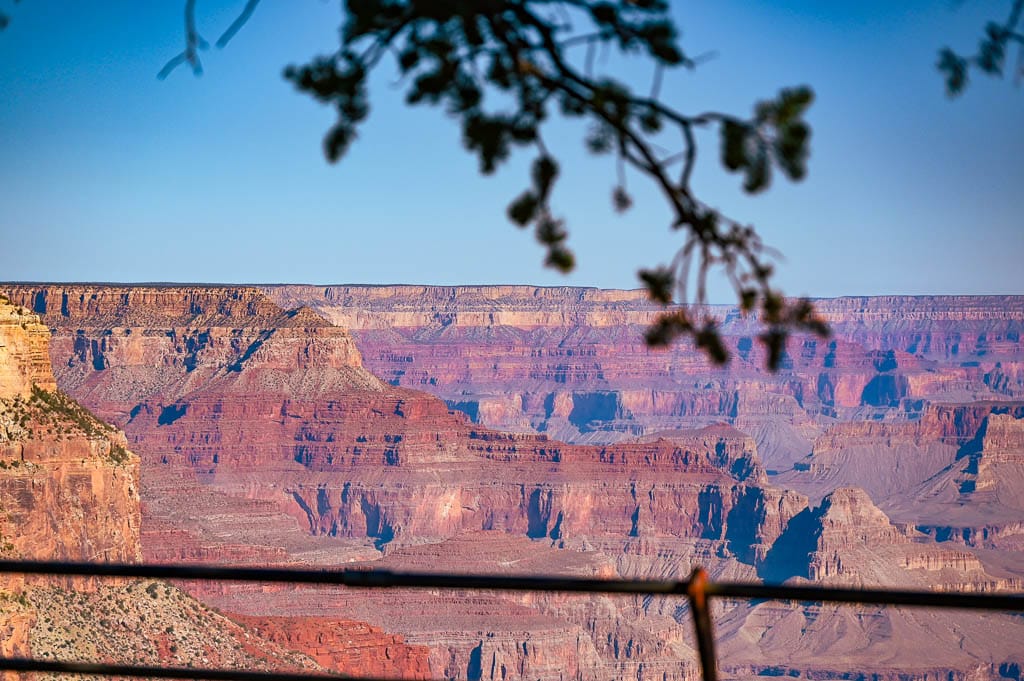
How to see the South rim of Grand Canyon
South Rim is located at an elevation of 7000 metre.
For a first timer to the Grand Canyon I suggest a visit to the South rim. It has decent travel infrastructure despite the rand Canyon area being a forlorn place. The trails are monitored, shuttles run on a schedule, camping grounds are frequented by travellers and many visitor centres are serviced within the National Park perimeter. In case you need help, you are likely to get it.
The South Rim is open for all twelve months of the year (unlike the North).
There are multiple observation points located on different routes at the South Rim. You can visit all of them on the free shuttles that ply at the park from sunrise to sundown.
You do not need a guide to explore the South Rim. It is easily doable by reading the sign boards.
You can walk the whole of the South Rim along the paved road. It is a 13 mile trail from South Kaibab trailhead to Hermits rest point. It takes almost 3 hours. You always have an option to ride the shuttle services in between. Mather Point, the Trail of Time, and Yavapai Point are a few of the most popular sections of the Rim Trail.
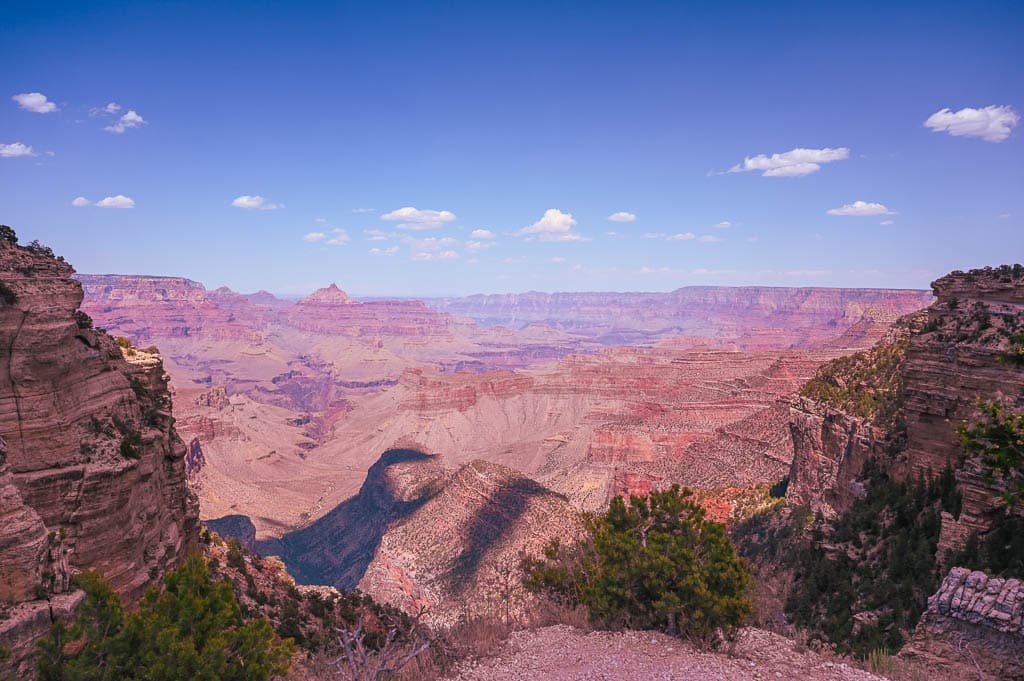
Tips for the Rim to Rim Hike at the Grand Canyon
Official estimates say, every year the Grand Canyon reisters 6 million annual visitors, making it the most visited national park of the United States.
Among those, a lion’s share visits the canyon for less than 4 hours. AT an average those people visit 20 minit near the view point, mostly Mather Point.
Less than 1% of the visitors actually go down the bottom of the Grand Canyon. A fraction of that number opt for the rim to rim hike.
Rim to Rim hike at the Grand Canyon is basically going all the way down the Canyon on a marked trail, spend a night at the base, explore the flora and fauna and enjoy canoe rides along the rapids of Colorado and climbing up the few thousand metre high canyon wall. Many hikers start from the south and go up the north. Please note, the North Rim of the Grand Canyon is closed during the winter months.
The Grand Canyon Rim to Rim hike is a bucket list adventure!
For the rim to rim hike at Grand Canyon, choosing the time of your visit is of paramount importance.
Heat and monsoon, both can cause extremely dangerous, muddy and difficult terrain to go down the Canyon. Temperature can easily go above 100 F. In summer, water sources down the canyon are scarce.
Apart from shorter daylight, Spring and winter in Grand Canyon allows you to pace out your journey without having to worry about gawking crowds.
It is possible to hike from the North to the South Rim of the Grand Canyon. It usually takes 2 days. There are campsites along the way. The trail is 21 miles(34 km) long. It is one of my US bucket list adventures!
The South Rim in a few hours
If you re on a day trip from LV or flagstaff to the Grand Canyon and have only few hours at the canyon, South Rim is still a good idea.
Your first stop will be at the Mather Point near the visitor center. You see the vastness of grand canyon. The vastness that shows why Grand canyon is really GRAND.
Apart from the view points you can stop at the Yavapai Museum of Geology and hike the Trail of time. Alternatively, you can drive down to the Desert View point and see a few more view points along the way.
If you have one full day at the Grand Canyon south rim, you can have a much better immersive experience.
Not just the visitor center, Mather point and the museums, you can actually explore all the view points and go for one small hike down the trail as well. Either Brigsouth Kaibab or the bright angel trail.
Do not forget to go for a star gazing experience at night. Due to its distance from an urban set up, the Grand Canyon has one of the darkest sky backdrop in the whole of the US.
A few of the day hikes from the South Rim of the Grand Canyon
The Bright Angel trail : Bright Angel Trail to Plateau Point (12 miles roundtrip) . It is steep in parts and has quite a few lookout points. Usually open from April, the Bright Angel trail features Havasupai Garden (Indian garden). Below this point, it is not recommended for day hikes. Mules re used in this trail regularly.
South Kaibab trail: South Kaibab Trail to Skeleton Point (6 miles roundtrip). You need to park at the visitor center, take the Orange Shuttle to Kaibab trailhead.
South Kaibab Trail to Cedar Ridge (or Ooh Aah point) (3 miles roundtrip)
Grandview Trail to the first overlook at Coconino Saddle (2.2 miles roundtrip, but steeper)
Bright Angel to Havasupai Gardens (8.9 miles roundtrip)
The Trail of Time connects Verkamp’s Visitor Center in the Grand Canyon Village to the Yavapai Geology Museum. This is a well marked and easy hike with many exhibits along the way educating you about the amazing history of the canyon. You will find about 13 informative panels and many rock samples from the deep of the canyon along this 1.7 mile hike. Look out for the brass markers along the paved trail which basically stands one each million years of the Grand Canyon!
I told you, the canyon slowly grows in your heart as you process more information related to its history.
The Hermit’s trail is a steep path of 2.5 miles( around 4 km). If you go till the end, which is Dripping Springs, it is a 7 Mile round trip. Water, shed, washroom- everything is rare. Further down the trail, the path leads to the Colorado river.
The Grand View Trail starts from Desert View WatchTower. Park your car at the visitor centre and start for this 6 mile long round trip along a super steep trail.Grand View Trail takes you till the Horseshoe mesa point however you can take a few detours and visit Cottonwood Creek and Page Spring too.
Please carry a pair of hiking poles to even out the pressure on your knees.
Unlike the usual hikes when you climb atop a mountain and feel like the queen of the world with sweeping views of Vista, the Grand Canyon hikes are very different. It takes you down from the majestic rim view and the world becomes narrower, warmer. It is as if you are walking into the belly of the Earth, like a protagonist from the Jules Verne novels.
The climb up is a rewarding experience if you are craving for such views. That said, going to the bottom of the canyon will bring you closer to various rock formations which are unforeseen in the greater part of the world. You will have many wildlife encounters on the path, from elks to spiders to curious squirrels.
The Grand Canyon Visitor Center
While there are many visitor centers and souvenir shops spread across the park, the main visitor center is housed beside El Tovar hotel. It has a beautiful plunging viewpoint by the side. Buckthorn bush abound the center. A local tea is made of it.
We stopped by to purchase a National Park passport. The Grand Canyon visitor center has a wide display of useful information to educate tourists with useful information and history of the area, the make of the canyon and present day changes that’s taking place beneath the rocks. It has an old world charm associated with it and I recommend you stop by! Souvenir ideas: postcards, sweatshirts, caps, magnets. Make your to check out he Canyon Village market as well for a nice little night shopping experience inside the National Park.
While we watched the Sunrise from Mather point with a bunch of other onlookers, I suggested we visit the Hopi point to watch the sunrise. Although this route may be closed during summer months for private vehicles. Hopi is a nice spot to watch the sunset as well. Hopi or Powell.
But the sunset show took my breath away at the Desert view watchtower. Due to shuttles not servicing this route, we had a calm and peaceful ambience to end the day in a joyous note.
Grand Canyon East- Desert View Drive along Route 64
Grand Canyon East is one of the least talked about point in the park which is easily accessible from the south rim. The entrance is open 24 hours a day, 7 days a week unless snow havocs the land.
Desert View Drive- From the Grand Canyon village, along route 64, you drive for 23 miles straight to arrive at the Desert View Tower. It is where the Canyon is done with the erosion work on the mountains and eventually proceeds into plainland. You see plain grassland at a distance. The river still proceeds to create a canyon but it lacks the drama of the highland.
The Desert View drive has many scenic stops enroute. The historic log cabins, the start point of old copper mining areas, the Duck on a Rock view point, far off Lipan point which is considerably less crowded and Navajo point are some of the most appealing stop en route.
The shoshone view point features a stunning sunset vista if you are willing to hike down a few miles during the golden hour.
While exiting the park, if you drive along State Route 64 you will come across stunning vista which is bereft of the maddening crowd. Much of this route is not serviced by the shuttle bus or commercial tour operators. It is at the Eastern part of the park, which is actually part of the South Rim.
Tips: If you have an annual pass to visit the National Parks, do make it a point to visit the Sunset Crater (USD 25 fees otherwise) and Wupatki National Monument (Indian ruins).
Next to the Red Route leading to Hermit’s Rest, my favourite spot at the Grand Canyon SOuth Rim was the Desert View WatchTower.
Mary Elizabeth Jane Colter, known as the architect of the SOuthwest and one of the earliest female engineers, had started the project back in 1932.
Taking inspiration from Hopi aesthetics, the 70 feet tall tower seamlessly blends with the surroundings. Like it was there at the beginning of the time. The murals on the walls are painted by Fred Kabotie, a member of the Hopi Native American tribe. The ceiling paintings by Fred Geary are inspired from the Abo Rockshelter, Salinas National Monument in New Mexico (from the NPS page).
Self Driving at the Grand Canyon or Shuttle Service?
The shuttle service at the Grand Canyon is FREE. Parking is FREE as well!
The best way to explore Grand Canyon or any of the American national Park is to drive your own vehicle. The roads are paved well and stretches to far off edges with well marked trails and directions. During the slower autumn and winter months from late October to Early March, not many opt to visit the Canyon. You might as well drive to the furthest point with a car without having to worry about finding a parking spot.
During summer months, the South Rim of Grand Canyon is brimming with tourists. The park is divided in multiple zones with routes, camping ground, parking area, lodges and features a regular shuttle service.
These shuttles are free and runs on 5 different routes. They run on a fixed schedule and can only take in as many guests as the number of the seats. The only hindsight is you have to wait for the next bus if seats are filled. Shuttle come in every 15 minutes.
There are three tourists shuttle routes at Grand Canyon South Rim:
Village Route (Blue) – Major connecting shuttles between the main visitor centre to the lodges, campground and other facilities.
Kaibab Rim Route (Orange) – The shuttle that takes you to the beginning of the Rim Trail and Yavapai Point and Geology Museum
The Red Route (Hermit’s Rest Point)- Route that overlooks 9 incredibly scenic overlooks and is closed for private vehicles in summer months.
The fourth route connects the park to the nearby village of Tusayan. This is useful for those who camp at Tusayan or park there during peak summer. This route is operational during spring summer season.
On the Red route (The Hermit Route), a regular shuttle service runs on a 10 min interval during summer. You would require to park the car at designated spot and take the Bus to visit viewpoints up to Hermit’s rest. We visited Grand Canyon in July, peak summer and self driving was limited on Red Route, leaving us with a choice between availing the shuttle service or walking on the rim trail. Self driving on the purple route was active.
Tentative 2024 Spring/Summer Schedule (SUBJECT TO CHANGE)
The Red Route is a 7 mile long route with many scenic view points.
The Hermit Road (Red Route) is open from 6 am until sunset each day.
The shuttle bus goes from 6 am to 11 am at a frequency of 20 minutes.
11 am onwards the frequency goes up to every 10 minutes until sunset.
Outbound buses(towards the Herrmit’s rest point) stop at all 9 overlooks.
On the return trip, the bus stops at 4 overlooks-Hermits Rest, Pima, Mohave, and Powell Points. Except for the last bus that stops at every Hermit route stops before being back to the village.
My suggestion is to start the day early when you are in the National Park. I can not recommend this enough. Especially in the summer months when the park witnesses maximum tourist footfall.
We drove down the Purple route and reached to the Desert View point on our own vehicle. Enroute, there were multiple view points. We stopped at some, took detour at some, skipped some as we dimmed fit.
You can also walk part of the rim trail and wait for the shuttle from the next stop. Many get down the bus and it runs empty for the next stop. The entire Shuttle roundtrip takes 80 minutes.
There’s also a shuttle between the South and North Rims, the Trans-Canyon Shuttle, which runs daily when the North Rim is open.
Please note,the Hermit’s Rest Route is serviced by private vehicle in the months of December, January and Februay, when there is no bus service.
The Red Route free shuttle service will be in service from March 1, through November 30, 2024. During this time, Hermit’s Route can only be accessed by the free Hermit Road (Red) Route shuttle bus, on foot, bicycle, or by commercial tour.
Bike routes along the Grand Canyon
The most economical and environmental friendly way to explore the canyon is to rent a bicycle. The 13 mile long Greenway trail is a biker’s dream adventure awaiting to unfold in the wild west! It is easy to rent a bike from the visitor center and venture into the many off the beaten track along the route.
Bike rental rates are available for 1-hour, half day, full day, and multi-day. One adult bike rental for a full day costs $40 plus tax.
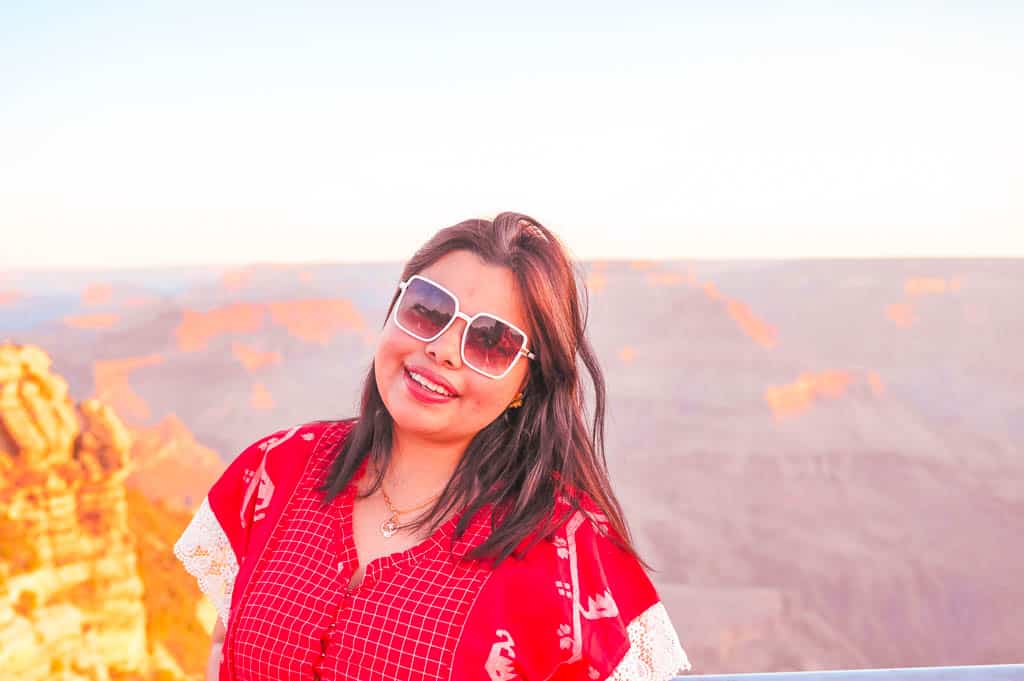
Grand Canyon Helicopter Tour
Flying on top of the majestic Grand Canyon is one of the pricier and unique ways to experience the canyon. A bunch of companies run helicopter tours, especially from LV. The tours run for about an hour and cost close to 300 USD per person.
Do I recommend it? Yes unless you have the gift of time to experience the canyon up close and personal. Flying on top of the canyon gives a totally different perspective but it leaves you longing for more in my mind!
Taking your pet to the Grand Canyon
I did not see many visitors visiting the Grand Canyon with pets. However I did see a kennel while driving our own vehicle towards the Hermit Point (and getting stopped with multiple markers on the way). There was a pack of pitbull that came out and looked at the car. My heart fills with love as I recall those mute animals were basically trying to tell us what’s your business entering this park? They were as surprised as we were!
Only a handful of spots are there in the Grand Canyon where you can take your furry friend along, in a leash. You can take your pet to the Mather Campground, Desert View Campground, Trailer Village and throughout developed areas. There’s only one lodge (Yavapai Lodge) that has pet-friendly rooms.
There is a kennel at the South Rim where pets can be boarded.
At the north of the Canyon, you can only take pets to the Bridle Trail and the portion of the Arizona Trail north of the park entrance station.
Packing List for Grand Canyon Trip
These are the mandatory things to pack for that Eppic Grand Canyon South Rim trip
Reusable Water Bottle- If you are planning a hike to the Bottom of the canyon or planning a visit to the many short trails at the South Rim, please be advised water is a scarce resource in the area.
Outfit selection- Bring a pair of cute dresses for the sunset viewing or dinner. However, do not forget your hiking gear and hiking shoes while visiting the Canyon.
Layering is important while visiting the Grand Canyon, especially during shoulder season as temperature can drastically drop during night. Bring a few light athletic jackets, pants, shorts (for summer season), gloves, thick tall socks to avoid blisters and insect bites during hikes.
Hiking boots/bags
Consider investing in a good hiking bag that carries water, snacks, phone, keys, and most importantly camera gear.
A good quality hiking boot will help you get a grip on the loose trails, mud, and save the ankle from a sudden bad step.
Hiking is incomplete without some good munching snacks, protein bars, gums to keep your mouth hydrated.
Sun protection: Arizona Sun can be harsh and punishing. Remember to apply a gentle amount of sunscreen before your head out and reapply every couple of hours. A hat, polarized sunglasses, lip balm are necessary accessories to visit the canyon.
Have you watched the film 127 hours? Ever since I did, I have put my heart into packing a first aid kit for accidents during hiking. A small First Aid kit does not hurt but comes very handy for mountain hikes. Band-Aids, Neosporin, a painkiller. A small scissor.
Stay Safe at the Grand Canyon National Park
There are many bus tours conducted from the nearby cities to the Grand Canyon. I say skip them. These are usually rushed affairs with only a couple of hours at a few viewpoints amidst a mind boggling crowd at the Grand Canyon. If you have a full day and can drive a car skip this. Rideshare may work too if you are fortunate.
Choose the right day hike- Choosing a suitable hike that fits into your day’s plan is an important factor to make this trip a success. The 3 mile long South Kaibab Trail to Cedar Ridge is a good start for a short hike into the Grand Canyon.
While hiking down the bottom of the Grand Canyon, walk slow and steady at a regular pace. Remember the hike up would be more challenging. Save water for that part.
Every hiking blog to the bottom of the Grand Canyon warns against same day rim to rim hike since it is a lot harder than what it may seem like. Please do not attempt this unless you are a pro at this.
The Grand Canyon is one of the most visited parks in the US. Summers are incredibly busy at the canyon. If you choose a visit during the shoulder season, you avoid the crowds. Weather would be more favourable for hiking.
Tip: Drinking inside the Grand CanyonNational Park is not allowed
Some of the canyon rim is not fenced. It is very much possible to fall in it. Please be careful.
For camping, book as early as possible. Get the permits. Join the lottery for the ranch stay (the Phantom ranch) at the bottom of the Canyon. These are limited resources and time sensitive ones. For Example, online lottery takes place 15 months prior.
Please do not lose anything at the trails. Keep your bag zip locked all the time. I heard a podcast where the visitors had a fancy tote and they lost their car keys while hiking down. It was a nightmare retrieving them and getting back to the nearest accommodation, especially during shoulder season when not many visit these trails.
Sunrise at the Grand Canyon is prettier and calmer than the Sunset when day trippers will join the watch party. Plan your day accordingly.
Let’s stay connected on Facebook, Instagram, Twitter, Youtube!
This post may contain affiliate links. Please read the disclosure post. If you have liked the article, you may support it by buying using these links without any extra cost to you.